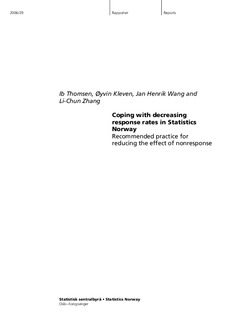Coping with decreasing response rates in Statistics Norway. Recommended practice for reducing the effect of nonresponse
Report
Permanent lenke
http://hdl.handle.net/11250/181229Utgivelsesdato
2006Metadata
Vis full innførselSamlinger
- Rapporter / Reports (SSB) [1696]
Sammendrag
Over the last two decades, cooperation rates in most sample surveys appear to have declined in many countries,
including Norway. As a consequence, the cost of conducting surveys has increased because repeated attempts must
be made in order to seek information from reluctant sample members.
In this report, we provide a review of experiences in Statistics Norway in the field of survey nonresponse. The report
presents a recommended practice manual, RPM, based on these experiences. As nonresponse is part of quality, we
treat the response process as part of the production process in a systematic quality approach, and recommend
methods and techniques applied to reduce unit nonresponse and its effects on the final official statistics.
The report is divided into five chapters:
Chapter 1 provides an introduction of some basic concepts within the systematic quality approach and some
recommendations.
Chapter 2 presents some response rates and nonresponse biases and their development over time and some
international comparisons.
Chapter 3 is concerned with household surveys. Key factors that have important impact on nonresponse are
identified. For many of these factors, key process variables are measured and applied to find a good balance between
cost and quality.
Chapter 4 gives a similar presentation concerning business surveys.
Chapter 5 presents techniques used to investigate the nature of the effects on nonresponse on the population
estimates together with the most commonly used weighting methods.
